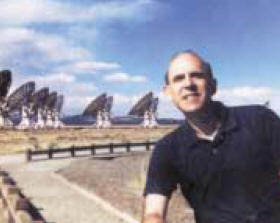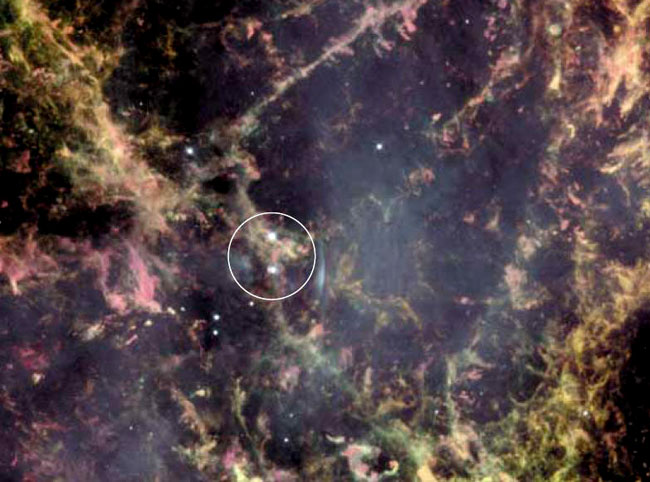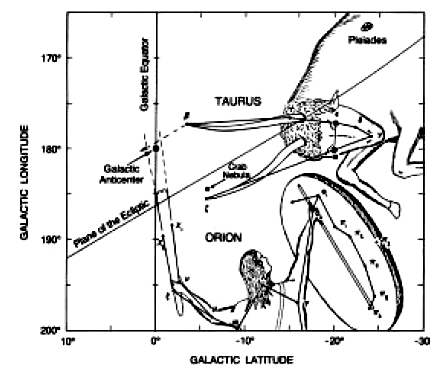|
from AtlantisRaising Website
Could the Enigmatic Phenomenon Be the Work of An Ancient ET Civilization?
It is the next step in the logical progression that began only 500 years ago with Columbus’ discovery of the spherical shape of the planet, continued with Galileo’s “heresy” that the earth revolves around the sun, Kepler’s discovery of elliptical orbits around the sun, and then, triumphantly completing the “Copernican Revolution,” Newton’s deduction, in 1687, of the Second Law of Mechanics and the Law of Universal Gravitation, which elegantly proved Kepler’s three laws of planetary motion.
Then, it wasn’t until Sir William Herschel developed a powerful telescope in 1781 that we began to peer out into the cosmos and to comprehend its complexity and immensity and to understand that what we thought were clouds of cosmic dust were actually countless other stars like our sun. Herschel, his son John, and his daughter Caroline eventually cataloged over 4,200 star clusters, nebulae and galaxies, thus setting the stage for the modern era of astronomy.
Then, with the orbital placement of the Hubble Telescope in 1990, we finally began to understand our stellar neighborhood. What has become known as the “local group” is dominated by our “Milky Way” and the giant spiral galaxy Andromeda, but also includes some minor galaxies. But even now, with all that we do know, we still know almost nothing about the implications of “membership” in our galaxy.
Has our solar system simply been
fortuitously “captured” by the immense centrifugal force of the
galactic hub, or does the entire galaxy somehow act as an organic
whole?
In his book, Earth Under Fire, (1997), he claims that astronomical and geological evidence suggests that a “protracted global climatic disaster” occurred on this planet, about 15,000 years ago.
Paul LaViolette, Ph.D.
Minute quantities of this rare isotope are produced when high-energy cosmic rays collide with nitrogen and oxygen atoms in our stratosphere. Since a time frame can be associated with each layer of the ice core sample, by measuring the Be-10 concentrations at various levels the fluctuations of cosmic bombardments of earth can be precisely determined.
The Vostok samples clearly showed a peak of
cosmic radiation between 17,500 and 14,150 years ago, associated
with a sharp increase in the ambient air temperature from -10 C to
about 0 C. This, claims LaViolette, caused the end of the Ice Age,
and ushered in the era of moderate temperatures that made modern
civilization possible.
But LaViolette has amassed an
impressive profusion of evidence, from many different sources, that
these events are much more frequent, and that they are really
massive bombardments of cosmic ray particles (electrons, positrons,
and protons) with the power of five to ten million “highly-charged” supernova explosions that reach, in full strength, to the
farthest limits of the galaxy!
He argues that pulsars are hi-tech galactic “beacons” very likely created by highly developed extraterrestrial civilizations, and are being used to signal the advent of galactic events, especially the “superwaves.” Both books, taken together, sketch out a fantastic scenario that radically changes the status quo astronomical, anthropological and archaeological landscape, and opens up a new universe of potential research and investigation.
LaViolette may well be just the pivotal researcher who lifts science out of stale, inbred stagnation into invigorating, human oriented realms and new directions for the 21st century.
The lower of the two circled stars in the crab nebula emits optical as well as electromagnetic pulses.
(Hubble Space Telescope) In view of the importance of his theories, we set up an interview for purposes of this article.
We spoke to him recently, and were totally
surprised at how deftly he was able to shift back and forth from
science to mythology to back up his ideas, reminding us in no small
way of a similar agility in another AR interviewee, Robert Bauval.
This idea of “continuous creation” is in direct opposition to the now generally accepted “big bang” theory, which most esotericists have never really been comfortable with, but which does seem to satisfy those religious groups who believe that “creation” was literally a single primordial act by God. A complete discussion of this subject can be found in LaViolette’s first book, Beyond the Big Bang: Ancient Myth and the Science of Continuous Creation, and also in his follow-on book, Subquantum Kinetics: The Alchemy of Creation.
The concept of the all-pervasive etheric substratum from which matter is created was really originally derived from ancient Hindu metaphysics, but had gained considerable scientific credence up until the late 19th century, when it was supposedly “put to bed” by the famous Michelson-Morley experiment in 1887.
However, this experiment was seriously flawed because it assumed the ether to be another physical dimension rather than a precursor to energy itself.
Today, while orthodox science may not
have granted respectability to etheric theory, they certainly don’t
mind using it every day to explain the propagation of radio and
television waves.
They disperse, and are then captured by the magnetic fields in the galactic nucleus. The superwave itself would not normally have much of an effect on the sun or earth, since the energy would be about 1,000th of that radiated by the sun. But the solar system is surrounded by a cloud of dust and frozen cometary debris which remain on the periphery because of the solar wind, which has an expelling action, and cleanses the entire solar system.
However, the super-wave, when it arrives, would push this dust cloud back into the interplanetary medium, and would block out the light of the sun, moon and stars, and the sun would appear to go dark. Also, the superwave and dust particles would energize the sun, and increase flaring activity so much that dry grasslands and forests would spontaneously catch fire.
This heat would also melt
the glaciers releasing tremendous quantities of water, causing
extensive flooding all over the planet. A whole panoply of cascading
catastrophes would then ensue including earthquakes and increased
seismic activity, high winds, failed crops and destroyed vegetation,
high ultraviolet radiation causing skin cancers and increased
mutation rates. In short, it would be a time of cataclysmic
destruction that would probably snuff out much of the human and
animal life on the planet.
The Greek myth of Phaeton, for example, the semi-mortal son of Helios, the Sun God, who was given the reins of the Sun Chariot and caused it to crash into the earth, thereby setting off a tremendous worldwide conflagration, is claimed to be a metaphor for that era when the superwave caused an extraordinary increase in infrared and ultraviolet emissions from the Sun, along with ultrahigh flaring activity. This could easily have caused a “scorched earth” phenomenon, according to LaViolette.
The Greek writer Ovid says of this event,
Then, as the glaciers melt and the ocean levels rise all over the world, large land masses would become submerged. This might easily account for the flood legends in just about every ancient civilization.
LaViolette compiled a list of about 80 societies with some sort of flood myth. He has no doubt that the deluge that sank Atlantis was caused by glacial meltwater.
He says,
Interestingly, the Phaeton myth concludes with massive flooding sent by Zeus to quench the flames.
According to
Plato’s Timaeus, this would have occurred about 11, 550 years ago,
right around the time of the last stage of the superwave.
This was not a new theory. Several scientists involved in the SETI project have speculated on this subject.
LaViolette tells us that Professor Alan Barett, a radio astronomer, theorized in a New York Post article in the early 1970s that pulsar signals,
It was, in fact, the first thought that occurred to the two astronomers who discovered the first pulsar signal in July of 1967 at Cambridge University in England.
Graduate student Jocelyn Bell and her astronomy professor, Anthony Hewish named the source of the signal “LGM 1,” an acronym for “Little Green Men.” By the time they published their astonishing discovery in Nature Magazine in February of 1968, having discovered a second pulsar, they were afraid to suggest an ETI (Extraterrestrial Intelligence) thesis because they feared ridicule from colleagues, and were afraid that the discovery would not be taken seriously by scientists.
But nevertheless, they
continued with this naming convention up to LGM 4!
This would have made it incredibly dense and much smaller, reduced from about three times the size of the sun, to no more than 30 kilometers. Gold theorized that as it rotates it emits a synchotron beam, much like a lighthouse beacon, which is picked up on earth as a pulses per second. It is brief radio pulse.
To match the pulsar frequencies, these stars would have to spin at rates up to hundreds of times per second.
LaViolette has compiled a very impressive and convincing set of reasons why the pulsars are very likely of intelligent rather than natural origin, and why they cannot possibly fit the Neutron Star model. They all relate to the fact that the signal is totally unlike any ever encountered in terms of both precision and complexity.
Some of the pulses increase in amplitude in varied, yet regular, patterns. Then many of the pulses exhibit something called “mode switching,” where the pulse suddenly exhibits an entirely new set of characteristics which persist for a time, and then it reverts back to its original mode. In some cases, this switch is frequency dependent, and in others the switching conforms to regular patterns.
LaViolette argues that an ET civilization would expect us to understand that such a complex signal must necessarily be intelligently designed. Perhaps they assume that we have the computer power necessary to comprehend the logic behind all the variability. The Lighthouse model has to be continually “stretched” to encompass these characteristics as they are discovered. At this point it has been contorted beyond recognition in order to explain this complexity, but astronomers are reluctant to abandon “the sizable mental investment involved.”
In terms of precision, some stars do show periodic regular variations in color and luminosity. Several binary X-ray stars pulse with periods accurate to six or seven significant digits. Pulsars, on the other hand, are from a million to one hundred billion times more precise!
La-Violette speculates that if Bell and Hewish,
(above) A star map shows the location of the Crab Nebula in the Taurus and Orion constellations. (below) LaViolette at work researching his theory.
The densest concentration is found on or near the galactic equator, not the galactic center as one would have expected if they were created out of supernova explosions, as theorized. Then they seem to clump around two points along the equator. These two points are precisely at the one-radian marks measured from the earth. A radian is a universally understood geometric measurement of an angle that marks off an arc around the circumference equal in length to the circle’s radius, and is always 57.296 degrees.
Using the earth as the center of the circle and placing the galactic center on the equator, perhaps the most significant pulsar in the galaxy falls precisely at a one-radian mark!
The so-called “Millisecond Pulsar” is the fastest out of all 1100 discovered to date. It “beats” at 642 pulses per second. It is also the most precise in timing being accurate to 17 significant digits, which surpasses the best atomic clocks on earth, and it emits optically visible, high intensity pulses.
This, he says, explains why two very unique (too complex to explain here) pulsars that LaViolette calls the King and Queen of Pulsars were positioned in the Crab and Vela nebulae, both of which were the sites of supernova explosions. He estimates that after reaching the earth about 14,130 years ago, the last superwave would have reached the Vela complex about 100 years later, and detonated a supernova there by heating up the unstable stars to the explosion point.
Then,
about 6,300 years later it would have reached the Crab nebulae, and
triggered a supernova there. These very large supernovas would have
become visible on earth at 11,250 B.C. and A.D. 1,054 respectively.
By placing marker beacons at these points, LaViolette believes that
the ET’s were giving us information about that superwave that we
could use to predict future waves with their associated cataclysmic
effects.
Therefore, the day may not be far off when earthlings can join
the
galactic community and help to inform some other unfortunate planet
of the approach of a fearsome galactic superwave.
|




